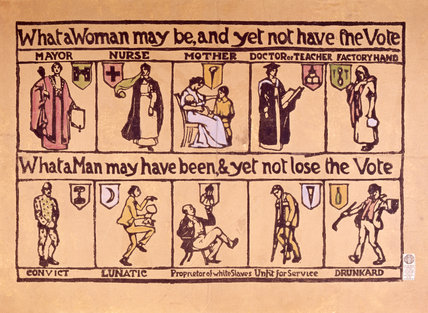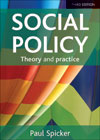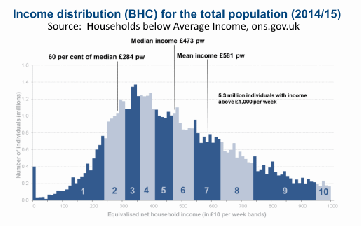
A poster for women to have the vote, 1912. The disapproving
references to disability and mental illness, and to 'white' slavers, do
not sit well with the standards of today.
An introduction to Social Policy

Inequality is not difference. Saying that people are unequal is saying that some are disadvantaged relative to others; inequality is disadvantage in a social context. The main inequalities in society are class, gender, race and inequalities in income and wealth.
Inequalities are usually represented in one of three patterns:
Social inequality is associated with social problems. The Spirit Level shows that societies which are more unequal tend to have not just more poverty, but more crime, more mental illness, more teenage pregnancy and so on. [1]
 Income
in most societies has a 'lognormal' shape, where people are bunched
near the bottom of the distribution but there is a long tail of richer
people; the graph from the UK is an example. Inequalities in
income are often shown by the Gini
Coefficient, which reflects the share of total income going to
different sections of the population. Norway has a Gini of 0.25, France
0.31, the USA of 0.4 and Mexico of 0.48. Some studies also
compare the income of people in the lowest fifth (or 'quintile') with
people
in the highest fifth. In the UK the quintile ratio is 1:7.2; in
some South American countries it is over 1:20.
Income
in most societies has a 'lognormal' shape, where people are bunched
near the bottom of the distribution but there is a long tail of richer
people; the graph from the UK is an example. Inequalities in
income are often shown by the Gini
Coefficient, which reflects the share of total income going to
different sections of the population. Norway has a Gini of 0.25, France
0.31, the USA of 0.4 and Mexico of 0.48. Some studies also
compare the income of people in the lowest fifth (or 'quintile') with
people
in the highest fifth. In the UK the quintile ratio is 1:7.2; in
some South American countries it is over 1:20. Inequalities of income have important implications for
welfare. Wherever there is competition for goods, such as
access to land or housing, people on lower incomes cannot pay as much
as their competitors and are likely to be excluded or
marginalised. The European Union identifies the risk of poverty
with 'economic distance' from the median or mid-point income, where
people's incomes are importantly less than other incomes typical of
that society.
Class is an ambiguous term, used in three main senses.
Economic position. Max Weber defined class in terms of relative economic position. There are obviously economic differences between people depending on how much money they have, but there are also many other economic groups - it is possible to distinguish people, for example, according to employment status, or the kind of income they have (such as fees, salaries, and social benefits). One classic analysis uses housing tenure as the basis for different classes.
Productive relations. Marxists understand class in terms of the economy. The main distinction in Marxism falls between those who own the means of production and those who sell their labour, but if the basic criterion is accepted there must be other classes: the petit bourgeoisie, who own small shops and firms, or the underclass (Marx's 'lumpenproletariat') who are marginal to the labour market.
Occupational status. Classifying people by occupational
status has proved very useful in sociological analyses of other issues,
including educational disadvantage
and health inequalities.
Occupational status for many works as a way of capturing information
about the 'life course', or changes in lifestyle over time.
Contemporary criticism of the concept has come about because there are
also many, especially women and migrants, for whom the links between
occupation and the life course are not so strong.
Weber describes status as a form of 'social honour' or esteem. People's social rank is associated with their class, but the terms are not equivalent; some social roles may have high esteem but low resources (like clerics).
The receipt of welfare has often been associated with social dishonour: the classic example of this is the "stigma of pauperism", the deliberate use of shame to stop people claiming from the Poor Law. The recipients of welfare are socially rejected; they are liable to be portrayed, like the pariahs of a caste system, as immoral, dishonest and dirty. [2]
Social policies tend to be concerned disproportionately with people of low status. In part, this happens because the client groups of the social services tend to be people who already have low social esteem - the poor, disabled people, mentally ill people, single parents and so on. In part, too, the receipt of social services may carry a stigma. The principle of institutional welfare was intended to remove degrading differences in status between recipients.
Power is complex; it can be used to refer to direct force, influence, or authority. Any of these is distributed unequally in society.
Power can be exercised overtly, but it may also be exercised in ways which are difficult to detect. Bachrach and Baratz argue that there may be non-decisions, which maintain the status quo through
"a decision that results in the suppression or thwarting of a latent or manifest challenge to the values or interests of the decision makers." [4]
Examples are delays, lack of interest in such subjects, and failure to respond to problems.
Further material: Welfare and society

A poster for women to have the vote, 1912. The disapproving
references to disability and mental illness, and to 'white' slavers, do
not sit well with the standards of today.
Social roles, or expectations, determine the range of opportunities for women and men. Understanding gender divisions is important for social policy, partly because issues affecting women are part of the agenda which social policy must tackle, but also because many of the concerns of social welfare - like poverty, health and old age - are related to gender.
Feminist critiques of welfare have argued that social policy is strongly 'gendered'. Jane Lewis [5] has suggested that, although the dominant models of welfare all assume that women are dependent on a male breadwinner, there are important variations:
Where assumptions are made about the position of women, this tends to reinforce women's inferior status and dependency. Where special provisions are not made, however, this tends to undermine the levels of protection which women receive if they have not earned income on the same basis as men. Widespread inequality in wages and conditions of work mean that 'gender-blindness' in social protection can only perpetuate inequalities.
External link: Women's rights (from the National Archive)
There are three main classes of feminist theory: liberal, marxist and radical. They share a common concern with gender as a focal issue in social policy.
Liberal feminism emphasises the rights of women as individuals. It argues against discrimination and stereotyping, and for equality of respect and opportunity. Arguments against limits to opportunity, like complaints against a "glass ceiling" to women's careers, are classically liberal: they suggest that women should benefit from the same inequalities as men.
Marxist feminism views the oppression of women as the result of the economic structure of society. Domestic relationships are seen in class and the relationship of the household to the means of production. Heidi Hartmann comments: "The 'marriage' of Marxism and feminism has been like the marriage of husband and wife depicted in English common law: Marxism and feminism are one, and that one is Marxism." [6]
Radical feminism argues that society is dominated by patriarchy, a structure of power in which men dominate women. Patriarchy is "sexual politics whereby men establish their power and maintain control".[7] This analysis is combined with the moral position that women should be able to live and act autonomously.
The issues of gender have become increasingly central to the work of
international organisations, reflecting the combined influence of
gender relationships with the experience of poverty: prominent issues
in development include not just the issues of violence, abuse and
discrimination reflected in developed countries, but property rights,
education and the central role of maternity in health.
Hopper identifies a long series of distinct approaches which have been taken towards gender in development work [8]:
External link: The Gender Inequality Index
'Race' has no fixed meaning. Although some commentators identify race closely with skin colour, the experience of racism is not confined to colour: the groups in Europe which experience the strongest rejection are probably gypsies and Muslims. Racial discrimination refers to a process of deliberate selection as a means of putting people from particular racial or ethnic groups in an inferior position, but deliberate discrimination is not necessary to explain much racial disadvantage; the effect of denying access to the resources, opportunities and conditions of life available to others is to make the experience of disadvantage worse.
Although issues of 'race' and racism feature largely in many discussions of the sociology of welfare, it is more difficult to point directly to policies which are directly concerned with race in intention and effects. Exceptions are the racialised ideas behind German Nazism, or the apartheid régime in South Africa, which offered different types and standards of social services to 'whites', 'blacks', 'Asians' and 'coloureds'.
More typically, policies concerned with 'race' are developed more obliquely. The American 'War on Poverty' in the 1960s, or the UK Urban Programme, addressed perceived racial problems through other means. The War on Poverty, which was instituted at the same time as civil rights legislation, has been represented as principally concerned to co-opt African Americans into the political process. Discussions of 'poverty' in the US are often still covertly racial in intent. The 'Urban Programme' in the UK was a desultory response to a notoriously inflammatory speech by Enoch Powell. The policy of the time coded such terms as 'inner cities' as a euphemism for race. The effect of working in code, of course, was that the problems of racial minorities were hardly addressed by the programme.
Further material: Welfare and society
A policy which corrects one inequality (e.g. between women and men) can aggravate another (e.g. between rich and poor, if the beneficiaries are richer women). For example, there is a current argument in India that attempts to avoid gender discrimination will discriminate between castes.
 Policies for equality can aim at
Policies for equality can aim at
A measure is redistributive if the people who receive goods or services from a measure are not the same as the people who pay. All welfare provision is, by definition, redistributive in some way.
Redistribution does not have to be from rich to poor. Redistribution is conventionally classified as vertical or horizontal. Vertical redistribution may be progressive (from rich to poor) or regressive (from poor to rich). Horizontal redistribution goes from one kind of group to another - from men to women, households without children to families with children, tenants to owner-occupiers.
Egalitarian redistribution is progressive, but there are many ways to achieve equality, with different effects. Rae outlines four strategies:
Further material: Poverty | Targeting
Titmuss identified several different kinds of redistributive process, arguing that it was not possible to understand the redistributive impact of social policy without taking them fully into account. He referred to a 'social division of welfare', including three main types of welfare:
1. social welfare (the social services);
2. fiscal welfare (welfare distributed through the tax system); and
3. occupational welfare (welfare distributed by industry as part of employment). [11]
The classification is fairly crude. The category of fiscal welfare bundles together subsidies, incentives and transfer payments, including income maintenance. Occupational welfare includes perks, salary-related benefits, measures intended to improve the efficiency of the workforce and some philanthropic measures,. The classification excludes legal welfare (redistribution through the courts), the voluntary sector and the informal sector. The importance of the idea was, however,
Tawney argued that public spending is the most effective way of redistributing resources. The aim, he writes,
'is not the division of the nation's income into eleven million fragments, to be distributed, without further ado, like cake at a school treat, among its eleven million families. It is, on the contrary, the pooling of its surplus resources by means of taxation, and the use of the funds thus obtained to make accessible to all, irrespective of their income, occupation or social position, the conditions of civilisation which, in the absence of such measures, can only be enjoyed by the rich.' [12]
The provision of universal benefits helps to create equality in its widest sense - the reassurance provided by social protection.
Julian Legrand argues against this that the universal social services are not available equally to all. The universal National Health Service in the UK gives health care disproportionately to middle class people. The state provision of education tends to be regressive, partly because people are poorest when the children are young, but mainly because it is the middle classes who gain most from education after the age of 16. Transport subsidies are worth most to people who travel the greatest distances, who tend to be middle class. And housing subsidies tend to favour home owners, who are more likely to be wealthy. In his view, the 'strategy of equality' proposed by Tawney has failed. [13]
Further material: Values in social policy
Further reading
P Spicker, 2006, Liberty, equality, fraternity, Policy Press.
This book is freely available, on open access.